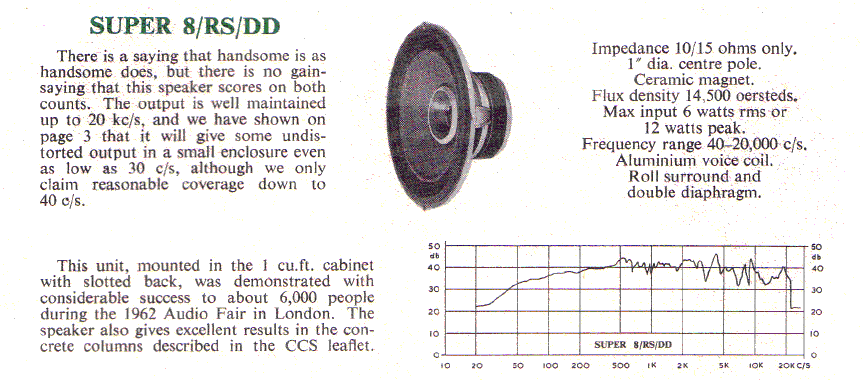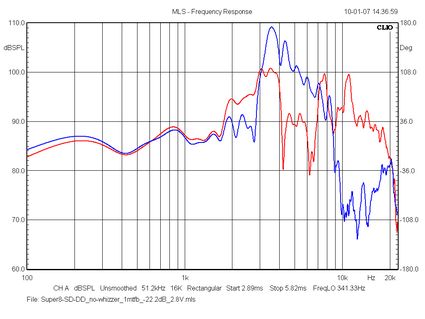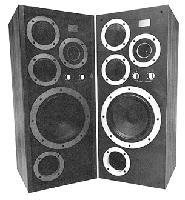| The Wharfedale Super 8/RS/DD - and much
more... (Richard Lee: black, Troels Gravesen: green) |
Mail #1 and my response: Dear Mr. Gravesen, The design of Super 8 is much more subtle than many people realise. eg. Different glues were used to stick the main and treble diaphragms to the coil. IMHO, the original was probably the best of the double diaphragm units with the possible exception of Lowther PM6. But it was a lot more versatile than the Lowther which really needed special loading like a horn. It had a flat (if somewhat ragged) response up to 20kHz which many 21st century speakers do not and certainly very few from its generation. One of the flattest and most extended frequency responses of a speaker from that era. But more important is that it sounded like it did too. It was not intended for open baffle. If you look at the Thiele parameters, you see it is nearly perfect for a 2 cu ft (50ltr) box tuned to 50Hz. Mount the units from the front, not the back. You can switch the green felt behind the chassis but why not leave it attractively in place and use draught excluder foam to seal instead. Your comment about, " high magnetic strength is not necessarily what makes us happy" is not quite correct. For a drive unit to be used in a reflex of sensible size, you need quite a lot of electromagnetic damping. Perhaps by chance, Super 8RSDD was one of the few units of its age which had correct Thiele parameters for the boxes it was used in. Part of this is the large magnet. 14500 lines is 1.45Teslas, a very high flux which could only be achieved with "Swedish" steels. Operating at such high Flux and in saturation has advantages in HF and distortion as well. It was necessary to achieve the correct electromagnetic damping with the small 1" coil. The small coil was needed for HF. Modern units which do not need full range operation use much lower flux levels. The knowledge and experience to design this type of unit is sadly nearly extinct. I was lucky to be in on the last days of this golden era. Two of these boxes on stands so that the axes cross in front of the listener so you are not listening on-axis gives much better than average stereo and sound, even by today's standards. The spiky, slightly elevated HF is nicely tamed when the speakers are placed like this. Bass is excellent. Many people used this arrangement in the early days of stereo and were amazed that such good performance was possible from (for those days) small boxes and units. You have to remember that a speaker is the sum of many things and this system would give a good account of itself even today, especially if power was limited. It was definitely better than the much more expensive Tannoys of that period which are so revered today. Alas, it is not possible to recreate such a system as the proper parts are no longer available. Doing so would bring back many happy memories of my youth. I must admit that my motivation for this email was really your remark to Mr. Briggs in heaven. Though I never met him in person, I cherish a letter from him encouraging my interest in loudspeakers. As all who had the slightest dealings with him, his kindness and good humour were never forgotten. The old man was very proud of Super 8RSDD and in my humble opinion, with good reason. It was certainly NOT a crummy driver. Perhaps the only one that could stand on its own merits against modern rivals in a stereo blind listening test. Please feel free to use any of this on your website. Richard Lee/Australia. Dear Richard Lee,
My catalogs here: http://www.troelsgravesen.dk/Wharfedale_cat.htm The Super 8/RS/DD I have are seen above (with whizzer cone removed) from non-coated surround (red) to coated surround (blue). Coating the surrounds will increase response in the ever so important midrange by some 5 dB, which is a lot! What I had hoped to see was something like this (brochure graph):
Any driver peaking some 15 dB at 3-4
kHz above average mid level simply doesn't sound well
unless facing upwards and listened to on-axis. The response graph above (brochure)
suggests something far better than the Lowther drivers. I
have recently had Lowther drivers on the bench - and I
wasn't impressed: http://www.troelsgravesen.dk/Lowther.htm. With the current interest in low-wattage triode amps steadily increasing I see no signs of decline - on the contrary. But high-efficiency speakers are still in demand, thus my own contribution in this area with the JA8008 driver: http://www.troelsgravesen.dk/JA8008_DTQWT.htm I still enjoy reading Briggs' book as I did almost 40 years ago and I believe Briggs must have been a charismatic person. I wish we could hear the "real
thing" but my Super 8 - as-is - is still the
worst driver I've had - among several hundreds. Coating
the cloth surround and crossing over at 2.5 kHz with a
4th order filter makes an indeed very good midrange and
bass - thanks to the straight-sided cone. I hope
you can answer the following questions: My comments to the following mail in green: Mail #2 and my response: Aa.. hh! A true aficionado. I'd better be careful in case he figures out I'm a fraud .... Dear Troels, My first experience with Super 8RSDD was when I was still in school in Singapore. I made speakers and sold them to my friends. I think I made at least 3 different kinds with Super 8. A pair in concrete drainpipes as in the Cabinet Handbook and 2 pairs to the Paraline design by Rex Baldock from (1963?) HiFi News. This was a Voight tapered line and the original was placed against the wall with the sound bouncing off it. Because the unit was on a 45 panel, it could also be used standing upright with the unit axes crossing in front of the listener. I think you are wrong when you say that
Lowther systems were not meant to be listened
off-axis. Us oldies were very aware that crossing
the axis in front of the listener gives better stereo and
for this, speakers with on-axis rising HF was good.
This ties in with much of Floyd's pseudo pontificating. I made a pair of Lowther Acoustas with PM6s which gave very good results this way for a customer. Much better sound than his Tannoy IIILZs. The column speakers had Super 8s pointing up and the Paralines with sound bouncing off the wall. The Paralines were my personal speakers for a long time and I preferred them as originally designed, bouncing off the wall. Even though in this period, I "graduated" to using KEF (and other) units and learning the rudiments of bass design. (Later, Wharfedale Bass design took a different tack from Thiele cos he was an academic. Most of his parameters are meaningless from a production viewpoint when you want a tool to help make more consistent speakers.) In 1975, I went to UK to try and enter the speaker industry. I spent 3 yrs working in the Wharfedale R&D Dept as a holiday student. This is when I first encountered Phil Escott of their Service Dept. The Escott brothers, Phil & Bill worked for GAB in the old days. I think Bill is mentioned in "Loudspeakers" as one of the best ears that GAB tested. When the Old Man retired, John Collinson (ex Quad) and Bill left Wharfedale to form Castle Acoustics while Phil remained to run the Service Dept. Because of this there was a lot of collaboration between the 2 companies. I think Castle actually made and sold the Castle Super 8RSDD for some time after Rank stopped making it. I hope you can help here because I
have recently bought two 8" units, Super 8/FS/AL
MODEL and North England M8; drivers from the Fifties I
believe and both having foam surround and there is not
the slightest sign of any polymer applied to the
surrounds in order to make the acoustically sealed. Was the foam surrounds ever coated, e.g. the
drivers used in the SFB? With the current interest in
low-wattage triode amps steadily increasing I see no
signs of decline - on the contrary. But high-efficiency
speakers are still in demand, thus my own contribution in
this area with the JA8008 driver: http://www.troelsgravesen.dk/JA8008_DTQWT.htm If you ever see a Wharfedale E70 or E90 on
eBay, try to have a listen. This were very brash
looking, 94dB/2.83V speakers designed in late 70's for
pop. What is not commonly known is that they were
also very accurate and good for classical.
In the late 70's, HiFi News attempted the 1st mass review of speakers with a crude Blind Listening Panel including 'Bat Ears' ********. The speaker which came top was the Wharfedale E70. This was a very efficient speaker; at 94dB @ 1m / 2.83V, well suited for 'pop'. The editor (John Crabbe I think) said, "we can't publish this" as the other speakers included some famous 'BBC' type designs. HA! I'm not surprised. Sad we can't have magazines telling the truth - or rather reviewers truly writing what they think of the products they are testing. I'm sure there would be quite some surprises. As often as I can find reviews from private people going to hifi shows I read them. More valuable than any magazine reviewer depending on manufacturers' advertising. In the 1st issue of HiFi Choice, this
speaker also did very well. ***** *******, who had
now given this very brash looking and loud speaker high
marks in 2 blind listening test series wrote what I
thought were very fair (if grudging) comments. The visually challenged **** ******** however, gave poor marks to what was at that time his favourite speaker; as did the rest of his panel. Instead of reporting this, he over rode the panel (and his own 'blind' comments) and gave his favourite speaker a high recommendation in that issue. This was why he was never asked to do another HiFi Choice. The bottom line is that even the best ears
are as prejudiced and opinionated as the most rabid
"Golden Pinnae" reviewer. My most successful design, the Delta 30 was,
for more than 7 yrs, the 2nd best selling speaker in
Europe and once, one of the 3 best small speakers in the
world. It looks and is a cheap speaker. I ALWAYS
score it higher in blind tests when I don't know I'm
listening to it. 1. Did Wharfedale ever use felt surrounds
for the larger drivers? Thanks! From looking at hundreds of
vintage Wharfedale drivers at eBay I think a lot of the
early drivers had polyester foam surrounds and when this
fell apart "re-foaming" was often done with
grey felt material. If the acousticians ever figure out why a
Stradivarius sounds the way it does, it will probably be
possible to duplicate the sound using appropriately
engineered industrial plastics! (I don't mean that as a
joke. I think we are a long way from doing this. If I can nudge the discussion back to some speaker material examples. The original Spendor BC1 bass unit had a modified PVC milky white surround. This had a magical midrange which was not equalled until much later. The problem was that it would revert to flat and was impossible to stick to. Wharfedale bought a pair of these originals. One of my jobs as R&D teaboy, was to stick the surround back on and check the speaker before any Blind Listening tests. Interesting. I guess this is the driver (pic. from a BC1 speaker found at eBay):
Very few of these were made for obvious reasons. Spendor quickly switched to a "rubber" surround which didn't fall off. These had the foam ring round the port. In the following decade, we bought two more pairs of BC1s at different times but in each case, they were unpacked, listened to, repacked and sent back the same day. They were good speakers but others, including our own designs, had caught up. The original (with wonky surround) was one of only 2 competitor's speakers we kept for more than a decade that might appear in our Blind Listening tests. The "rubbers" available for surrounds were always dictated by what the tyre manufacturers were using. A less exotic example is cone materials. Unique Fibrous Material is still the ideal cone material. It's only problem is inconsistency. I've tried to achieve its properties with an engineered plastic with some success but only up to a sensitivity of about 90dB/watt. This homopolymer polypropylene with mica fill is no longer available. Above this, paper rules. Carbon Fibre and Kevlar don't have the right properties for superlative midrange. OK for subwoofers. That's not to say, there haven't been advances in materials. Fibreglass roof insulation is the best material for stuffing boxes and lasts forwever. Now we just need something cheap with its properties but more human friendly. A pricy organic alternative is Dr. Bailey's long fibre wool off the backs of sheep from the Yorkshire Dales. While I could agree / dispute certain points, I'd urge anyone buying speakers to ALWAYS listen to them first, preferably at home and definitely with your own music, IGNORING anybody else's pontificating if you come across a pair that YOU like. Thanks for all your comments.
Interesting reading. Back to Wharfedale Super 8/RS/DD page. Mail: 09-05-2009: I was
employed as a technician by the Australian import agents
for Wharfedale spkeakers;Simon Gray P/L., inthe '60's. I
can confirm that the photographs of the referenced
speaker shown on your website are indeed that for that
model and date i.e. 1/67 as clearly marked on the
cone. Later models differed only in that a black Paint
was used on the aluminium dome instead of the translucent
blue coating and a slightly modified frame. There were
many assembly problems with this model in the
Rank/Wharfedale era caused by increased production
demand. The coil and former required additional
coating (doping) to fully bond the coil and to stiffen
the paper former.The cloth roll surround was rarely fully
sealed and leaked air.The stepped cone was not a good
choice as it was intended for the U.S. market which
sought a higher power handling capacity i.e. a 1.5''
voice coil version. Often the aluminium dome was
not fully bonded to the tweeter cone causing odd
distortions if not buzzes. After a few years the black
rubber sealant dried out causing the the surround
to stiffen. The suspension then became non- linear as the
roll rather than the corrugated disc spider controlled
the restoring
force.
Barry M. Arnstein. Dear Barry, thanks for the additional information. This makes a lot of things fall into place. Best regards, Troels. |




